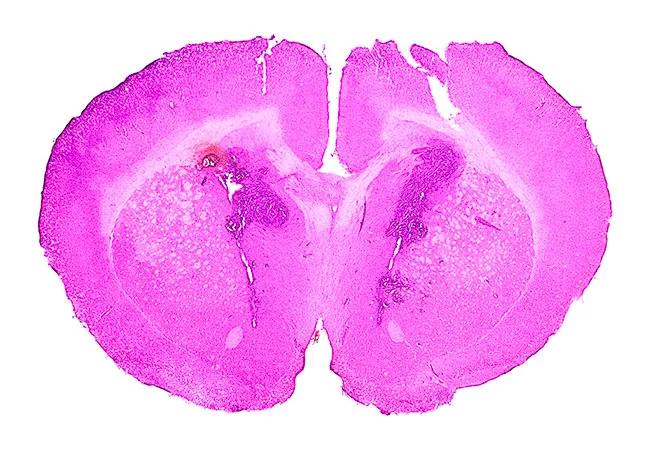Molecular targets may offer noncytotoxic treatment path

Cytotoxic chemotherapy and radiation have for several decades been the mainstay treatments for advanced gliomas. These therapies intend DNA damage. The cellular response to this damage is upregulation of the tumor suppressor protein p53 and its key co-factor p16. p53/p16. in turn, upregulation of these co-factors activates programs that attempt to repair the damage, and if the damage persists, trigger cell-suicides (apoptosis also known as cytotoxicity). But gliomas typically mutate and/or delete p53 and/or p16, thereby compromising chemotherapy and radiation efficacy. The chemotherapy and radiation treatments meanwhile do destroy p53/p16-intact normal cells to cause toxicities.
Advertisement
Cleveland Clinic is a non-profit academic medical center. Advertising on our site helps support our mission. We do not endorse non-Cleveland Clinic products or services. Policy
It is logical therefore to pursue new treatment approaches that can work even when p53/p16 are absent and chemotherapy and radiation fail. Recent insights into the genetics and epigenetics (gene packaging) of gliomas point to specific molecular targets for such non-cytotoxic treatments, as described in a perspective and review appearing in International Journal of Cancer.
“Our reliance on crude impositions of stress, to thereby activate cytotoxicity as the means to terminate glioma and other cancer growth, is because we did not understand enough about the molecular mechanisms driving relentless cancer growth,” says senior author Yogen Saunthararajah, MD, staff and professor of medicine, Department of Translational Hematology and Oncology Research in the Cleveland Clinic Taussig Cancer Institute. “Absent such understanding, we could not envisage elegant repairs to restore normal cell function and purpose. Instead, we have had to attempt to compel cell-suicides via physiologic insults. The conventional approach is a search and destroy paradigm. The state of the science today opens doors toward healing, repair paradigms instead, to hew more closely to core values and goals in medicine.”
Glial cells are physiologic and physical supports for the neurons in our brains; they are specialized cells vital for normal brain health. Genes that must be activated or turned on for a cell to become a specialized glial cell (‘late-glial genes’) have a critical property: They are wrapped up in our chromosomes, such that extensive unpackaging work, called chromatin remodeling, must be executed first. By contrast, the genes that all cells rely on to grow and divide (‘replication genes’), and the genes that are activated to define commitment toward becoming specialized glial cells (‘early-glial genes’), are accessible. They are configured or packaged in such a way that they are primed for activation, even in the earliest cell-type of all, the embryonic stem cell.
Advertisement
The cancer evolution process that produces lethal gliomas exploits these constitutive differences in chromatin configuration by selecting to disrupt the chromatin-remodeling machinery needed to activate final specialized glial cell programs. The consequence is glial lineage-committed cells that are stalled in their journeys to becoming specialized glial cells; they “spin their wheels,” growing and dividing in place, producing relentless, uncontrolled cell growth. Replication without onward glial-lineage differentiation equates to malignant self-replication.
The specific chromatin remodeling components disrupted vary by glioma subtype and by pediatric versus adult gliomas. The number of these abnormalities increases as the gliomas evolve and become more aggressive. The final consequence is the same, however: Increased friction against activating late-glial genes and thereby increased replications.
Stated another way, gliomas depend on packaging, or ‘off’ enzymes, to keep late-glial genes ‘off’ so that they can continue to replicate. Drugs to inhibit the ‘off’ enzymes that maintain late glial genes in a wrapped-up inaccessible configuration therefore resume glial-lineage journeys to stop their growth. Specific ‘off’ enzyme molecular targets reviewed and discussed in the article include DNA methyltransferase 1 (DNMT1), Isocitrate dehydrogenase (IDH1, IDH2), Enhancer of Zeste 2 polycomb repressive complex 2 subunit (EZH2), chromodomain helicase DNA binding protein 4 (CHD4) and dihydroorotate dehydrogenase (DHODH).
Advertisement
Dr. Saunthararajah explains, “Inhibitors of these enzymes have been shown to work well against gliomas in the test tube and in animals, exploiting the fact that gliomas are poised to transition into nondividing specialized glial cells. This transition occurs because they highly express key glial-differentiation-driving transcription factors NFIA, ATF3 and RUNX2, even as they are at the same time in no hurry to commit suicide with absent p53/p16.” He adds, “Such an approach aligns with a Hippocratic dictum that natural forces within us are the true healers of disease.”
To translate this science into effective clinical therapy for gliomas, the authors have identified two key challenges. The first is that many of the available drugs to inhibit ‘off’ enzymes much more easily penetrate into blood cells than into brain cancers, such that effects on blood counts in patients may limit the ability to achieve the intended target engagement in brain cancers. The second challenge is that gliomas disrupt several chromatin remodeling components needed to turn on late-glial genes, and engaging just one or two of their opposing ‘off’ enzymes may be insufficient; several may have to be inhibited safely.
To address these challenges, the researchers at University of Heidelberg and Cleveland Clinic have been developing new drugs that are better able to penetrate into brain cancers, and tailoring their dosages and schedules to limit or avoid cytotoxicity and side effects, to enable safe combinations of the drugs to inhibit several ‘off’ enzymes simultaneously. They are developing these drugs and regimens toward clinical trials, to hopefully be initiated in the near term.
Advertisement
Advertisement

Obstructing key protein allows for increased treatment uptake for taxane chemotherapy

Oral medication reduces epistaxis and improves quality of life for patients with rare vascular disorder

Findings could help with management of a common, dose-limiting side effect

Enfortumab vedotin plus pembrolizumab benefited patients, regardless of biomarker expression

Treatment involved checkpoint inhibitor, surgery and intravesical therapy

Researchers Assess Real-Life Experiences of Patients Treated Outside of Clinical Trials

Multi-specialty coordination essential for improving quality of life